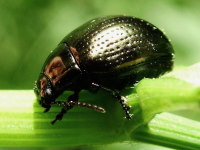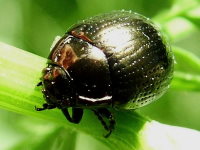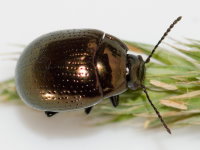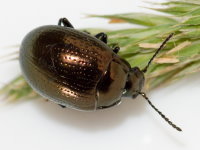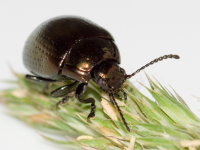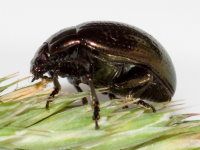Phylum Arthropoda (Arthropods) ➔ Subphylum Hexapoda (Hexapods) ➔ Class Insecta (Insects) ➔ Order Coleoptera (Beetles) ➔ Family Chrysomelidae (Leaf beetles)
Chrysolina (Sulcicollis) oricalcia (Müller O. F., 1776)
Wiesenkerbel-Blattkäfer
Synonyms and other combinations:
Chrysomela oricalcia Müller O. F., 1776 |
Classification:
Chrysolina oricalcia belongs to the subfamily Chrysomelinae, tribe Doryphorini.Distribution:
Europe (missing on the Iberian Peninsula), east to Ukraine and Turkey; Siberia?Habitat:
Wet tall forb communities, humid forests and clearings near streams.In Central Europe often in montane or submontane regions, in Northern Europe only in the lowlands.
Description:
Length 6 - 9 mm; short-oval species; upper side bronze-coloured, sometimes blue or green; elytra with distinct rows of dots; pronotum mostly smooth or very finely dotted; sides of pronotum straight, strongly converging to the front; side edges of pronotum set off from base by a sharp notch.Biology:
Chrysolina oricalcia is a predominantly crepuscular and nocturnal species that lives oligophagous on various umbellifers (Apiaceae), especially on cow parsley (Anthriscus sylvestris). Other host plants are Chaerophyllum, erect hedgeparsley (Torilis japonica), Cicuta virosa, hemlock (Conium maculatum) and ground elder (Aegopodium podagraria).Chrysolina oricalcia hibernates as imago. The females of the ovoviviparous species give birth to their larvae in early spring. In ovoviviparous animals the embryos develop in eggs which remain in the mother's body until hatching. The embryos feed on the yolk contained in the egg (yolk sac). The larvae develop in 3 - 5 weeks. They pupate in an earth cave in the ground. After about 3 weeks the new generation hatches, which is active from July to September and then disappears for hibernation.
References, further reading, links:
- Rheinheimer, Joachim, & Hassler, Michael: Die Blattkäfer Baden-Württembergs, 2018, 928 pages, Kleinsteuber Books (Karlsruhe), ISBN 978-3-9818110-2-5
- Arved Lompe: Die Käfer Europas - Ein Bestimmungswerk im Internet
- Agelastica alni
- Altica sp.
- Aphthona nonstriata
- Bromius obscurus
- Bruchus rufimanus
- Bruchus sp.
- Cassida nebulosa
- Cassida rubiginosa
- Cassida sp.
- Cassida stigmatica
- Cassida vibex
- Cassida vibex/bergeali
- Cassida viridis
- Chrysolina fastuosa
- Chrysolina haemoptera
- Chrysolina hyperici
- Chrysolina lucidicollis
- Chrysolina oricalcia
- Chrysolina sp.
- Chrysolina sturmi
- Chrysolina varians
- Chrysomela populi
- Chrysomela tremula
- Chrysomela vigintipunctata
- Clytra laeviuscula
- Clytra quadripunctata
- Coptocephala sp.
- Crepidodera aurata
- Crepidodera aurea
- Crepidodera fulvicornis
- Crioceris duodecimpunctata
- Cryptocephalinae sp.
- Cryptocephalus moraei
- Cryptocephalus nitidus
- Cryptocephalus pusillus
- Cryptocephalus sp.
- Donacia bicolora
- Donacia cinerea
- Donacia marginata
- Donacia versicolorea
- Galeruca tanaceti
- Galerucella s.l.
- Gastrophysa viridula
- Gonioctena decemnotata
- Gonioctena quinquepunctata
- Gonioctena quinquepunctata/intermedia
- Gonioctena sp.
- Gonioctena viminalis
- Lema cyanella
- Leptinotarsa decemlineata
- Lilioceris lilii
- Lochmaea caprea
- Neocrepidodera ferruginea
- Neocrepidodera sp.
- Oulema melanopus/duftschmidi
- Oulema obscura
- Pachybrachis sp.
- Phratora sp.
- Phratora vitellinae
- Phyllobrotica quadrimaculata
- Phyllotreta armoraciae
- Phyllotreta nemorum
- Phyllotreta vittula
- Plagiodera versicolora
- Plagiosterna aenea
- Plateumaris sp.
- Podagrica fuscicornis
- Psylliodes sp.
- Pyrrhalta viburni
- Sphaeroderma sp.
- Xanthogaleruca luteola
